

Reverse Archeology by rongo rongo
September 26th, 2008 6:05 AMTourism. Tourism is the opposite side of the coin for archaeology. When something catches the popular imagination, like Thor Heyerdahl's Kon-Tiki, it helps draw funding for scientific archaeology (even when it is scientifically and archaeologically unsound). However, once a site become popular, there is more pressure to "restore" it in order to give the tourists something more dramatic to look at. Restoration, historically, has often been plagued by mistakes and caused damage to irreplaceable antiquities. Tourism also causes a lot of wear and tear---witness the degradation of the cave art at Lascaux, graffiti on the pyramids, and problems at Angkor Wat.
So, in preparation for a trip to Easter Island (where I will see some moai which were toppled by the indigenous culture and then re-raised mainly by foreigners), I engaged in some T-shirt making. T-shirts are one of the essential tourist trappings. The saying "Been there, done that, got the T-shirt" captures the strength of this association.
The designs below are based primarily on drawings by Georgia Lee of petroglyphs found on Easter Island. I noticed something cool when drawing the manupiri design. Back when I reproduced some rongo rongo glyphs for the waiting game, I had no idea what glyph 543 might represent. Now, I think the glyph might be a representation of the negative space within a manupiri design. The shape is remarkably similar, and this particular glyph is done with a double outline instead of the typical single outline, which implies that it's a different kind of representation. Coincidentally, one of the guesses during the waiting game for this glyph was clans in conflict. The manupiri is a symbol of extended clan and relations, so maybe the negative space would correspond to clan conflict! My own theory, based on nothing other than personal speculation and minimal observation---hey, it's the opposite of archaeology! Now I'm really ready to go to Easter Island.
(I will probably not be able to read SF0 much for the next three weeks. So have a good time, I'll be thinking of you folks and everyday life, and I'll be back around SF0 again after this trip.)
Turtle
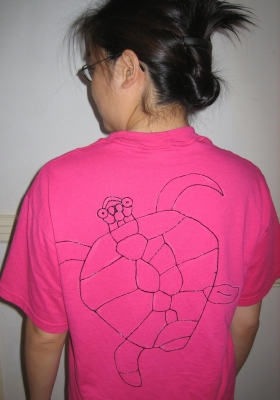
When Polynesians settled Rapa Nui, they found an island with almost no animal life. No mammals, no reptiles, just seabird and ocean dwellers. Petroglyphs depict a variety of different sea creatures, from realistically rendered turtles to abstract octopus designs to fanciful swimming spirit.
Tuna
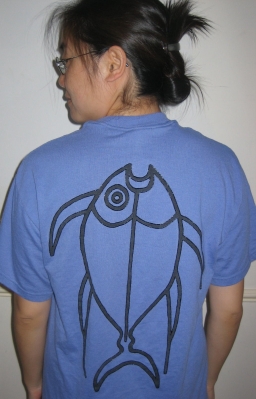
One of Georgia Lee's anecdotes about her stint on Easter Island during the 80's, when she was the first to methodically study the petroglyphs, is about the way people would ask tourists flying off the island to take packages to their relatives in Chile. (Chile is about 2000 miles away, but it's the country that owns the island, and the nearest place on the mainland.) One day, some unsuspecting fellow agreed to oblige a pretty woman and take a Christmas gift to her Dad. The gift turned out to be a whole tuna, wrapped in burlap, leaking fishy juice on the poor guy all the way over.
Manupiri
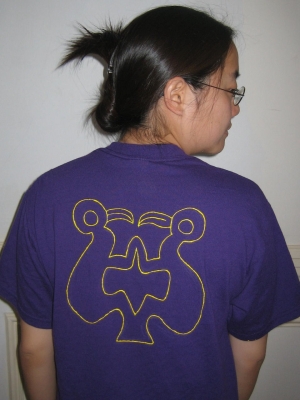
This sort of figure is called a tangata manu (man bird), or a manupiri when two of them are stuck together. There was a birdman cult that involved candidates vying to swim shark infested waters, lurk around a tiny island, and be the first one back with the season's earliest sea bird egg.
Rooster
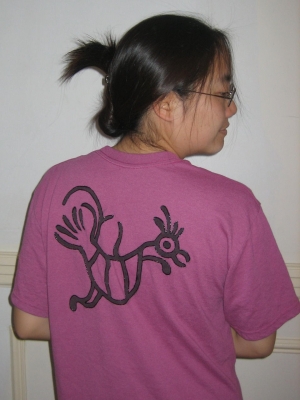
Chickens, rats, dogs, and pigs were the typical food animals brought by Polynesian settlers. Apparently, dogs and pigs didn't really make it on Rapa Nui back in the pre-contact days, but the chickens and rats did okay.
10 vote(s)

Jellybean of Thark
3
Charlie Fish
1
emma ungoldman
3
Haberley Mead
1
JJason Recognition
3
KristinawithaK
1
Spidere
5
Zephyr
2
Augustus deCorbeau
2
Palindromedary
Terms
(none yet)2 comment(s)
Points for the logic! The frigate bird is probably my favorite.






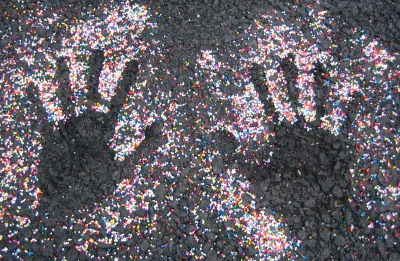











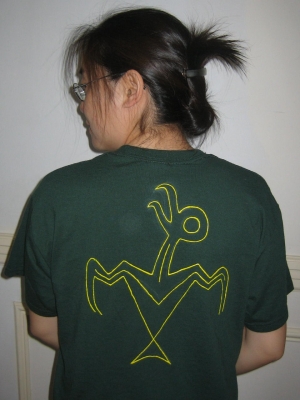

Nice. Good work with the t-shirts. Have fun over there.